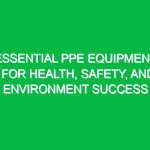Introduction
Warehouse safety is a critical aspect of the Health, Safety, and Environment (HSE) domain. It encompasses a variety of practices and procedures aimed at ensuring the health and safety of all personnel working in or around a warehouse. With the rise of e-commerce and increased demand for storage and distribution services, the importance of effective warehouse safety measures cannot be overstated. Accidents in warehouses can lead to severe injuries, legal liabilities, and significant financial losses. Therefore, implementing robust safety protocols is not only a moral obligation but also a strategic business decision.
In this article, we will explore essential warehouse safety tips that can help prevent costly accidents. By focusing on practical measures, legal requirements, and real-life examples, we aim to provide a comprehensive understanding of warehouse safety that aligns with HSE standards. Whether you are a warehouse manager, employee, or safety officer, these insights will empower you to foster a safer work environment.
Understanding Warehouse Safety: The HSE Context
In the context of warehouse operations, safety refers to the practices that protect workers from physical hazards, health risks, and environmental dangers. The HSE framework outlines various guidelines and regulations that aim to mitigate these risks. The primary elements of warehouse safety include:
- Hazard Identification: Recognizing potential hazards like slips, trips, falls, and equipment-related risks.
- Risk Assessment: Evaluating the level of risk associated with identified hazards.
- Control Measures: Implementing strategies to minimize or eliminate risks.
- Training and Education: Ensuring all employees are aware of safety protocols and emergency procedures.
- Monitoring and Review: Continuously assessing safety practices and making necessary adjustments.
Each of these components plays a vital role in creating a safe warehouse environment. By understanding and applying these principles, warehouses can significantly reduce the likelihood of accidents.
Key Aspects of Warehouse Safety
1. Training and Education
Training is the cornerstone of warehouse safety. All personnel must receive comprehensive training on safety protocols and emergency procedures. This includes:
- Safe operation of machinery and equipment.
- Proper lifting techniques to prevent back injuries.
- Fire safety and evacuation plans.
- Usage of personal protective equipment (PPE).
Regular training sessions, refresher courses, and on-the-job training can enhance employees’ skills and awareness. For example, a large logistics company implemented a quarterly safety training program that resulted in a 30% decrease in workplace accidents over two years.
2. Proper Use of Personal Protective Equipment (PPE)
The use of PPE is crucial in protecting workers from potential hazards. This includes items such as gloves, helmets, safety shoes, and high-visibility clothing. Employers should ensure that employees understand the importance of PPE and how to use it correctly. Conducting regular inspections of PPE can also help ensure that it is in good condition and effective.
A case study involving a distribution center showed that providing employees with high-quality PPE reduced incidents of injury related to falling objects by 40%.
3. Maintaining a Clean and Organized Workspace
Cluttered and disorganized workspaces can lead to accidents. Ensuring that aisles are clear, spills are cleaned immediately, and equipment is stored properly can significantly reduce risks. Implementing a 5S methodology (Sort, Set in order, Shine, Standardize, Sustain) can be an effective approach to maintaining cleanliness and organization within the warehouse. Employees should be encouraged to take ownership of their work areas and report any hazards promptly.
4. Implementing Safe Material Handling Practices
Material handling is a significant aspect of warehouse operations, and improper handling can lead to severe injuries. Here are some practices to consider:
- Use forklifts and pallet jacks for heavy loads instead of manual lifting.
- Train employees on the proper techniques for lifting and carrying.
- Install racking systems that comply with safety standards to prevent tip-overs.
In a real-life scenario, a warehouse that adopted ergonomic material handling practices saw a 50% reduction in musculoskeletal injuries over a year.
5. Regular Maintenance and Inspection of Equipment
Regular maintenance and inspections of warehouse equipment are essential for safety. Equipment, such as forklifts and conveyor belts, should be routinely checked to ensure they are functioning correctly. Failure to maintain equipment can lead to mechanical failures and accidents. In a case where a warehouse implemented a strict maintenance schedule, they reported a significant decrease in machinery-related accidents, highlighting the importance of preventive maintenance.
6. Implementing an Effective Emergency Plan
Every warehouse should have a well-defined emergency plan that includes procedures for fire, chemical spills, and severe weather events. Employees should be familiar with evacuation routes, emergency contacts, and safety equipment locations. Conducting regular drills can help ensure that everyone knows their role during an emergency. A notable incident involved a warehouse that experienced a fire drill; post-drill evaluations indicated that employee response times improved significantly, showcasing the effectiveness of regular training.
7. Utilizing Technology for Safety Enhancement
Technology can play a vital role in enhancing warehouse safety. Implementing safety management software can help track incidents, manage training, and monitor compliance with safety regulations. Additionally, using automated systems for inventory management can reduce human error and improve efficiency. A warehouse that adopted RFID technology reported a decrease in inventory-related accidents by 25%, demonstrating the impact of technological integration on safety.
Identifying and Addressing Potential Hazards
Understanding potential hazards is crucial in preventing accidents. Common hazards in warehouses include:
- Slips, trips, and falls: Often caused by wet floors, uneven surfaces, or cluttered walkways.
- Forklift accidents: Resulting from improper operation or lack of training.
- Falling objects: Caused by inadequate racking systems or improper stacking techniques.
- Chemical exposure: Arising from improper storage and handling of hazardous materials.
Addressing these hazards requires a proactive approach, including regular safety audits, employee feedback, and continuous improvement of safety protocols. For example, a warehouse that conducted monthly safety audits was able to identify and rectify potential slip hazards before they resulted in accidents.
Regulations and Standards Governing Warehouse Safety
There are various regulations and standards that govern warehouse safety, particularly in the HSE context. Notable regulations include:
- Occupational Safety and Health Administration (OSHA): Sets standards for workplace safety and health in the United States.
- Health and Safety at Work Act (HSWA): A UK regulation that outlines the duties of employers to ensure the health and safety of employees.
- European Agency for Safety and Health at Work (EU-OSHA): Provides resources and guidance for safety practices across Europe.
Compliance with these regulations is not optional; it is a legal requirement. Non-compliance can lead to severe penalties, including fines and legal action. Additionally, adherence to these standards fosters a culture of safety that benefits both employees and the organization. Regular training on these regulations can ensure that employees remain informed about their rights and responsibilities related to warehouse safety.
Conclusion
Warehouse safety is an essential aspect of the HSE domain that requires continuous attention and improvement. By implementing effective safety protocols, training employees, and adhering to regulations, warehouses can prevent costly accidents and promote a safer work environment. The safety practices discussed in this article, such as proper training, organized workspaces, and emergency preparedness, are vital for minimizing risks associated with warehouse operations.
In summary, fostering a culture of safety not only protects employees but also enhances overall productivity and efficiency. Investing in warehouse safety is a proactive approach that pays dividends in the long run. As warehouse operations continue to evolve, ongoing commitment to safety will be crucial in navigating the challenges and opportunities that lie ahead. Remember, a safe warehouse is a productive warehouse.


